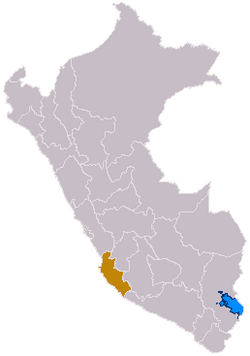13°27′04″S 76°10′15″W / 13.45111°S 76.17083°W

The Chincha culture (or Ica-Chincha culture[1]) was the culture of a Native Peruvian people living near the Pacific Ocean in south west Peru. The Chincha Kingdom and their culture flourished in the Late Intermediate Period (900 CE–1450 CE), also known as the regional states period of pre-Columbian Peru. They became part of the Inca Empire around 1480. They were prominent as sea-going traders and lived in a large and fertile oasis valley. La Centinela is an archaeological ruin associated with the Chincha. It is located near the present-day city of Chincha Alta.
The Chincha disappeared as a people a few decades after the Spanish conquest of Peru, which began in 1532. They died in large numbers from European diseases and the political chaos which accompanied and followed the Spanish invasion.
The Chincha gave their name to the Chinchaysuyo Region, the Chincha Islands, to the animal known as the chinchilla (literally "Little Chincha"), and the city of Chincha Alta. The word "Chinchay" or "Chincha", means "Ocelot" in Quechua. The Chincha are an ethnic group related to the Quechuas people.
- ^ Muzzo, Gustavo Pons (1979). Summary of the History of Peru. Editorial Universo.
The Chincha Culture had its principal seat in the valleys of Ica and Chincha. It is also known by the name of Ica - Chincha Culture.